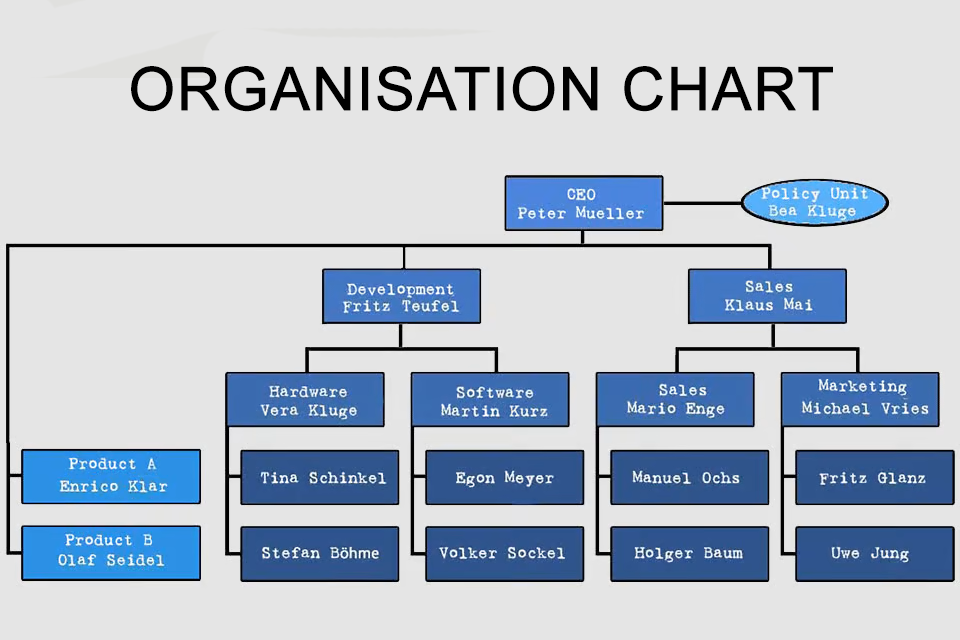What is an Organisation Chart?
Table of Contents: Definition – Types – Elements – Advantages and disadvantages – Questions from the field – Notes
Smartpedia: An organisational chart – also known as organigram – shows the structure of companies or parts of companies with organisational units, responsibilities and tasks.
Organisation chart – the representation of organisational structures
An organisation chart – also known as organigram – is the diagram of an organisation. It shows the structure of companies or parts of companies and thus the organisational units with their tasks or functions, their superiors and often the formal communication channels.
The term Organigram, which is made up of the words organisation and diagram, was first used around 1855 by Daniel Craig McCallum¹, a railway manager from Scotland who worked in New York. Although the organisation chart was invented more than 160 years ago, it is still the preferred representation for organisational structures today.
Alternative terms for the organigram or the organisation chart are for example organisation plan or organogram.
Different types of organisational charts
Organisation charts are graphical representations that depict the structure of an organisation. They can be created in different ways, depending on the needs and structure of the organisation. Here are the most important types of organisational charts:
The hierarchical organisational chart is the most classic form and shows the organisational structure in a pyramid shape. At the top is usually the CEO or management, followed by various departments and their sub-departments. This structure emphasises the vertical hierarchies and the chain of command, with each level being subordinate to the next higher levels. This model is particularly suitable for traditional companies with clear power relationships and reporting lines.
In contrast to the hierarchical model, the flat organisation chart shows a less staggered structure with few or no middle management levels. This type of organisation chart is typical for smaller or more modern companies that focus on flexibility and teamwork. Decision-making paths are shorter and employees often have more autonomy. This can promote communication and cooperation, but also harbours the risk of ambiguity in the allocation of responsibilities.
The matrix organisational chart combines elements from different types of structure and is often used in companies that have a combination of functional and project-based organisation. Employees report to both a functional manager and a project manager. This dual reporting line can increase flexibility and utilise resources more efficiently, but often leads to conflict and confusion if it is not clear which priorities take precedence.
The circular organisation chart depicts the organisation as a circle, with the leadership positioned in the centre and the other departments arranged concentrically around it. This shape is often used to emphasise the equality and collaboration between different departments or teams. It is a visual departure from the traditional hierarchy and promotes a sense of community and common purpose.
In a functional organisation chart, departments are organised according to their specific functions, such as marketing, finance or production. Each department is represented in its own branch and is managed by a department head. This structure is particularly suitable for companies that rely heavily on specialisation and expertise. However, it can lead to departments working in isolation and less interdisciplinary co-operation.
Each of these organisational chart types has its specific advantages and disadvantages and is suitable for different organisational structures and requirements. While the hierarchical organisational chart provides clarity and structure, flat or circular organisational charts can promote collaboration. Matrix organisational charts offer flexibility but carry the risk of overlap and conflict. The choice of the right organisational chart should therefore be carefully adapted to the specific needs and goals of the organisation.
Elements of an organisation chart
An organisation chart is a graphic representation that visualises the structure and relationships within an organisation. The most important elements of an organisational chart are boxes and lines, titles and names, connections and directions as well as colour coding and symbols. These components work together to provide a clear overview of organisational structures and communication channels.
Boxes and lines form the basis of every organisation chart. The boxes represent positions, departments or units within the organisation. These boxes usually contain titles and names to show the role of a particular person or department. For example, a box could contain the title ‘Sales Manager’ and the name of the person who fills this position. The connections and directions between the boxes, represented by lines, illustrate the relationships and communication channels. In an organisation chart, these lines are normally drawn vertically and horizontally to show the hierarchical levels and reporting channels.
Visually, the organisational chart representations correspond to an abstract tree diagram, even if the connections or relationships between individual nodes of the units (locations, divisions, departments) – drawn as rectangles – are not visualised as branches, but by means of horizontal and vertical lines. These lines illustrate how the different positions are connected and how communication flows within the organisation.
A key distinguishing feature of organisational charts is the type of connections, which are shown either as single-line systems or multi-line systems. In a single-line system, there is a clear relationship between two units. This means that each unit has only one superordinate unit from which it receives instructions, creating a clear and simple hierarchy. In contrast, in a multi-line system, subordinate units are assigned to several higher-level units. This structure, in which the lines are drawn horizontally, vertically and diagonally, shows that a unit receives instructions from several managers. This can increase complexity, but also encourages a more flexible and dynamic way of working.
Colour coding and symbols can be used in an organisational chart to provide additional information and facilitate interpretation. For example, colours could be used to identify different departments, or symbols could highlight specific roles or responsibilities. These visual aids support understanding and make complex structures easier to comprehend.
Advantages and disadvantages of organisation charts
Working with an organigram offers some significant advantages:
- The structure of an organisation with its organisational units and tasks can be presented easily and is basically easy to understand.
- The responsibilities and responsibilities within an organisation or organisational unit are easy to read.
- The communication and formal exchange of information along the documented hierarchies is easy to understand.
But there are also some disadvantages:
- Organisational charts are very simplistic. In many companies, hierarchies and communication channels are often formed independently of organisational units. Especially in times when networks are seen as an essential component for an exchange at eye level, the organisation chart serves as a kind of “enemy image”. One reason for this is the interpretation of the organigram as a structure of authority, power and decision-making.
- Temporary organisational units such as project organisations are difficult to represent.
- Complex organisational forms require additional information; otherwise information is interpreted. Example: A policy unit – usually represented as an ellipse in a staff line system as shown in the diagram above – supports a department or a department manager. Whether or not the employees of this staff unit are authorized to give instructions to the employees of the department cannot be deduced from the representation. The situation is similar with cross-sectional functions such as purchasing, logistics, etc.
- Organisation plans must be maintained, because they are a snapshot of a reference date. This is obvious when presenting a project organisation, because the project organisation usually dissolves when the project is completed. But even company organisations are usually not permanent, e.g. when employees take on new tasks, new departments are created or company divisions are sold.
Many companies today are dealing with topics such as agile or hybrid transformation, with learning and virtual organisations. It therefore remains to be seen to what extent the organisation chart will be used in the future.
Questions from the field
Here you will find some questions and answers from the field:
What is a digital organisation chart?
Strictly speaking, this is not a diagram type in its own right, but rather a modern development and form of presentation based on digital platforms. The term ‘digital organisation chart’ refers to the way in which the organisation chart is created, managed and displayed:
- Users can click on different parts of the visualisation to obtain additional information such as detailed descriptions, responsibilities or contact information.
- Tools can provide different views of the visualisation depending on what information is to be highlighted (e.g. project-based views, functional views, etc.).
In today’s practice, any of the classic organisational charts (hierarchical, functional, matrix, etc.) can be displayed in digital form.
What is the difference between a hierarchical and a functional organisation chart?
The difference between a hierarchical and a functional organisation chart lies in the way in which the organisation is structured and presented. Both charts are used to show the relationships and responsibilities within an organisation, but differ in their orientation and focus:
The hierarchical organisation chart shows the organisation as a pyramid, with the top management level (e.g. the CEO or board) at the top and the subsequent levels below. Each level represents a level in the hierarchy and the vertical lines illustrate the reporting and instruction paths from top to bottom. This diagram thus emphasises the hierarchy and clearly shows who reports to whom. It emphasises authority and reporting lines, with power and decisions flowing from top to bottom.
In the functional organisation chart, the organisational units are structured according to their specific functions or areas of activity, e.g. marketing, sales, production, finance, human resources, etc. Each functional unit has its own section in the organisation chart, which is managed by a department head or functional head. This chart emphasises the specialisation and expertise within the organisation. It shows how the individual functions in the organisation are structured and interact with each other. This is less about hierarchy and more about functional organisation.
What is the process for creating an organisation chart?
- Determine the purpose of the organisational chart. Should it depict the entire organisation or just a specific area? Should it illustrate the hierarchy, the functions or the communication channels?
- Think about who will use the result (e.g. managers, employees, external partners) and what information is relevant for this group.
- Capture the current structure of the organisation, including all departments, teams, positions and reporting lines.
- Talk to key people in the organisation to get accurate and up-to-date information. Make sure you have the names, titles, departments and reporting relationships of the relevant people and positions and choose the appropriate presentation format based on the existing organisational structure.
- Consider how to organise the positions and departments logically to ensure a clear overview. Functional departments can be displayed next to each other, while subordinate positions are placed below the higher-level units.
- Draw boxes for each position or department and connect them with lines to show the hierarchy and reporting paths. Include relevant information in the boxes, such as titles and names of people or departments. And make sure the connections are clear and correct. Use vertical and horizontal lines to make the relationships clear.
- Make sure the layout is clear and well structured. All elements should be evenly spaced and easy to read.
- Last but not least, have the organisation chart reviewed by the relevant managers or department heads to ensure that it is correct and complete.
PS: It is advisable to use a tool for the creation that comes with ready-made templates. Ideally, these templates are customisable.
What are typical mistakes when working with organisational charts?
- An organisational chart is only as good as the data on which it is based. If the information is outdated or incomplete, the organisational chart may not accurately reflect the actual structure of the organisation.
- A chart that contains too many details or is too complex becomes difficult to understand and loses its clarity. This often happens when trying to show every single position or relationship, especially in large organisations.
- A visualisation that is difficult to read because it is too small, crowded or visually confusing loses its function.
- Lines that are inaccurately or confusingly arranged can distort hierarchies and relationships. Particularly problematic are intersecting or unclear lines that make it difficult to follow the flow of information.
- An organisation chart that does not show the hierarchy levels correctly leads to confusion about responsibilities and reporting lines. This can occur when levels are incorrectly organised or positions are placed on the same level without clear differentiation.
- A presentation that is not updated regularly can quickly become outdated and convey incorrect information, which can lead to wrong decisions.
Conclusion: Typical mistakes when working with organisational charts include the use of unclear data, excessive complexity, lack of reader-friendliness, incorrect line management and disregard for hierarchies.
Does ‘the customer’ belong in an organisation chart?
Opinions vary as to whether customers (and also suppliers, service providers, etc.) should be shown. Customers in an organigramm express that
- employees should focus more on customers and less on the organigram.
- organisations should think from “outside inwards and outwards again” and not from “top to bottom”.
- the organisation primarily serves the customers and not the top of the company.
As an argument against customers in the organization chart, it is argued that the representation depicts the
- organisational structure,
- formal power relations and communication channels,
- authority to issue instructions and information flows.
Furthermore, it is argued that
- there are departments that explicitly deal with customers,
- customers can not be collected in a box like any department,
- customers belong to the environment of the organisation.
The organisation chart is therefore not the appropriate tool to express customer focus.
Organisation plan equals hierarchy. Hierarchy does not equal organisation plan.
Notes:
[1] Information about Daniel Craig McCallum can be found here.
Some publications state that the purpose of an organigram is to visually represent the organisational structure in such a way that managers and stakeholders can see how the company and its internal procedures and processes work. However, an organigram is NOT a flow or process description.
Here you can find free organisational chart templates for MS Powerpoint, MS Word and MS Excel.
Furthermore, tools such as Lucidchart, OrgChart or Miro offer the possibility to create organisational charts online.
If you like the article or would like to discuss it, please feel free to share it in your network. And if you have any comments, please do not hesitate to send us a message.
Here you will find additional information from our t2informatik Blog:



